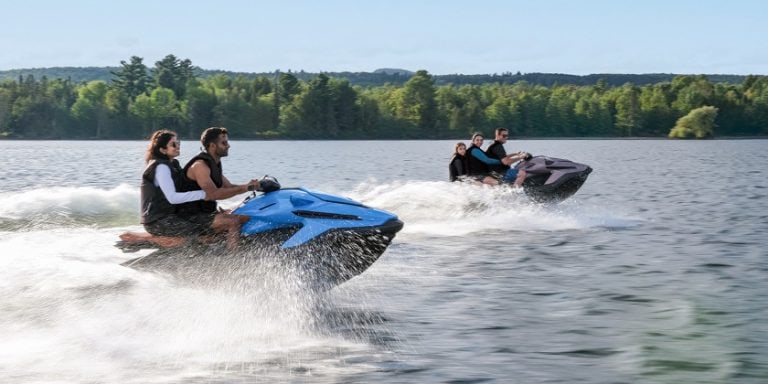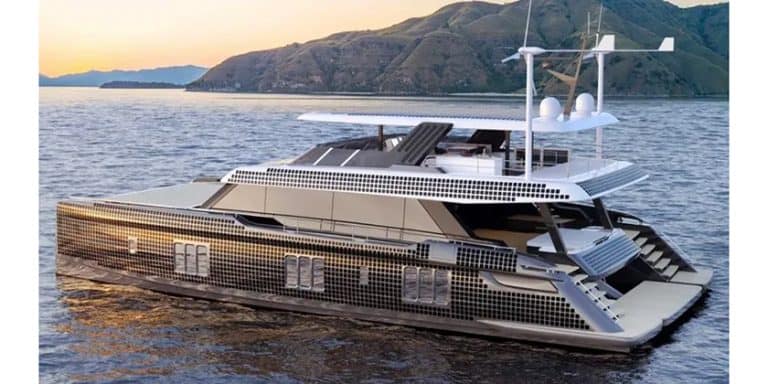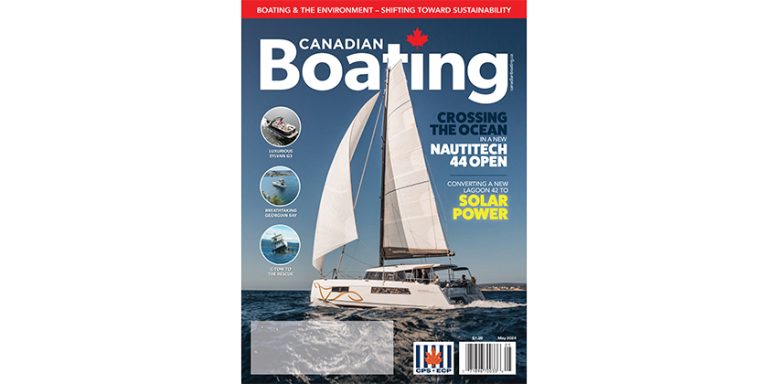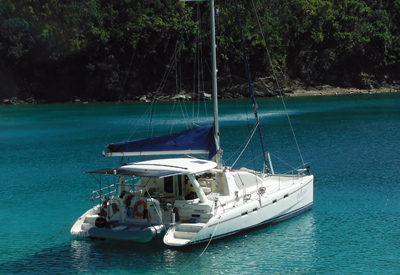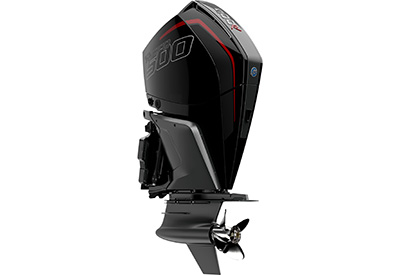Tricking out a new Lagoon 42
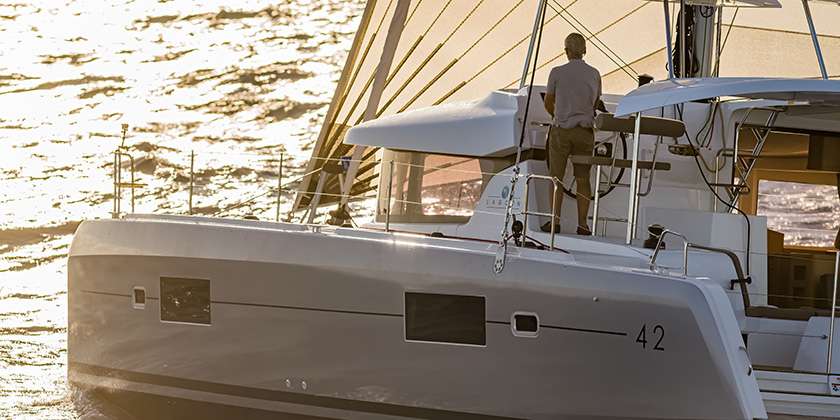
By Mike Wheatstone
I recently had the pleasure of checking out a brand-new Lagoon 42 catamaran to see what it came with, in the way of factory installed electronics and what you could add to make it comfortable for cruising off grid. The proud new owners were seeking extended cruising independence, energy efficiency and the comfort and quiet of generator-free mooring in Georgian Bay.
The owners planned a solar system to achieve their goals. Here is what they did.
Solar Power
The most obvious addition to the vessel is a stainless-steel arch mounted aft of the Bimini. The arch supports five 425W panels for a total of 2,125 W. These panels are bifacial, generating electricity from sunlight striking both sides of the panel for an increase in power of up to 25%. See figure 1 and 2.

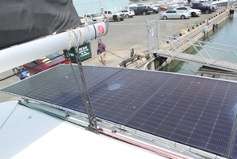
A further two walkable deck mounted panels on top of the Bimini will be added shortly to further increase solar power generation.
To handle the voltage conversion from solar panel to battery and control battery charging, a total of seven Victron 150/45 MPPT controllers are fitted in the starboard engine room. MPPT controllers can harvest up to 30% greater energy than a simple pulse width controller. By pairing one controller with each individual solar panel, power generation is maximized by minimizing the negative impacts of shading on any one of the panels. See figures 3 and 4.
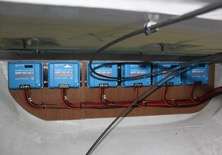
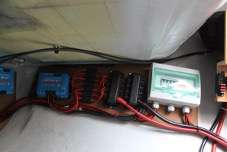
Batteries & Inverters
From the factory the Lagoon came with 360Ah of AGM lead acid batteries. The owner has contracted to have these replaced in the fall with 600Ah of lithium. With their greater useable energy density this will be equivalent to over 1200AH of lead acid.
As part of the lithium upgrade, two Victron 3000W inverters are being installed. These inverters will power the main AC loads consisting of the air conditioning, induction cook top, and hot water tank.
The large battery bank (with solar charging) and inverters allow these loads to be supplied without needing to install a generator. This saves weight (always critical in a catamaran), allows the vessel to use less diesel fuel, and is one less piece of rotating machinery to maintain. While the capital cost of the lithium battery upgrade with the Victron Inverters is comparable to the purchase and install cost of the generator, going forward the reduced running and maintenance costs of the batteries and inverters make that the better solution. As an added bonus, the physical real estate normally taken up by the generator will be used for a second freshwater tank and additional storage.
The entire power system will be monitored by a Victron Cerbo GX and GX Touch 50 5” touch screen. In addition to seeing graphically the state of the electrical system (battery charge, AC & DC power consumption, solar charging), with inputs for tank level, temperature sensors, user definable digital inputs and user definable relay outputs, the owner can monitor and control the health of the entire vessel. The owner can also view, control, and configure this information remotely over the Internet using Victron’s VRM (Victron Remote Management).
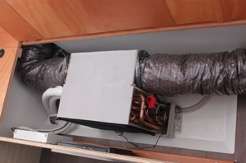
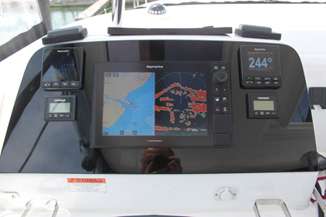
Navigation Electronics
The Lagoon comes with what I would call a glass helm station. It consists of a Raymarine I70S networked display (with multiple pages of data such as wind speed and direction available), Raymarine I70S Axiom Pro 12 Multi- Function Display (with radar), and a P70S auto pilot control head. If you look closely you can see the chart shows the vessel tied up in Port Credit Harbour Marina.
You can also see the two Yanmar displays for the two engines in the “glass Helm station” shown in figure 6.
Located below the glass helm is another compact but powerful unit. It is the wired handset for the Garmin Vesper Cortex V1 hub VHF radio with AIS transponder and remote vessel monitoring.
The handset offers single hand operation with touchscreen, thumb wheel and oppress keys. The Cortex unit has a built-in AIS transponder to allow you to see nearby vessels and them to see you. Radioing vessels in a crossing situation has never been easier; just tap the vessel’s icon on the touch screen. Applications running in the Cortex system controller allow the owner to monitor boat systems, receive alerts (such as anchor watch) and remotely control connected devices from their smartphone. NMEA 2000 connectivity is included allowing vessel data to be shared among devices such as the Raymarine MFD. Additional wired or wireless handsets can be added for use at other locations such as the internal nav station. See figure 7.
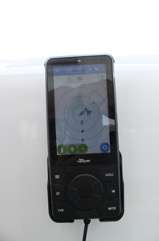
The results after cruising south
We contacted the owner in early April 2024 to ask how his project has gone. The response was that they are happy with the results. It’s cost a little bit more than he expected. In fact, it was about equal to putting in a generator but in the long run he feels it will be less expensive.
Backups and redundancy are always a smart idea and they carry a little Honda 2,000 watt generator that they can fire up to top up the batteries as needed. Recharging the batteries at a marina can be quite costly because they charge shore power by the kilowatt. As a side note, on many Caribbean islands, electricity is produced by diesel powered generators so that electricity is by no means ‘green’. No wonder it’s expensive.
The owners also shared that overall, the system is still being optimized with the help of online service connections. They recently added Starlink to the boat allowing them to monitor it wherever it is. They run 24/7 connections and that gives them depth, wind information, security camera connections and more.
They were planning to finish their cruise in mid-April, returning to Georgian Bay where they will be focusing on the Parry Sound area to Killarney and then the North Channel this summer.
Overall
Overall, the owners would certainly recommend this solar system upgrade to other people but for this first installation, they wound up using several different suppliers and working with many different people because they wanted the latest systems. For example, the batteries came from the United States, the air conditioning system was from Italy and the bifacial solar panels came from France. By the way, those bifacial panels look very nice and people often comment on their appearance. The big benefit is that they also get 25 to 30% more power. They learned a lot by being part of a Lagoon owners group.
The practical benefit of having this solar power system is that you sleep a lot better when there’s no generator running at night. They also have some great luxuries onboard such as a 50-inch plasma television as good as home. The owner points out that it’s like being at home although for obvious reasons they conserve energy where they can.
They really enjoy the boat and they’re very happy with the solar power system. However, they make the point that this should be available as a factory option. Whether you want it or not, the boat comes equipped with old technology and they had to remove that equipment and discard it to be replaced with the newerequipment – something the factory should consider when building their option list.

